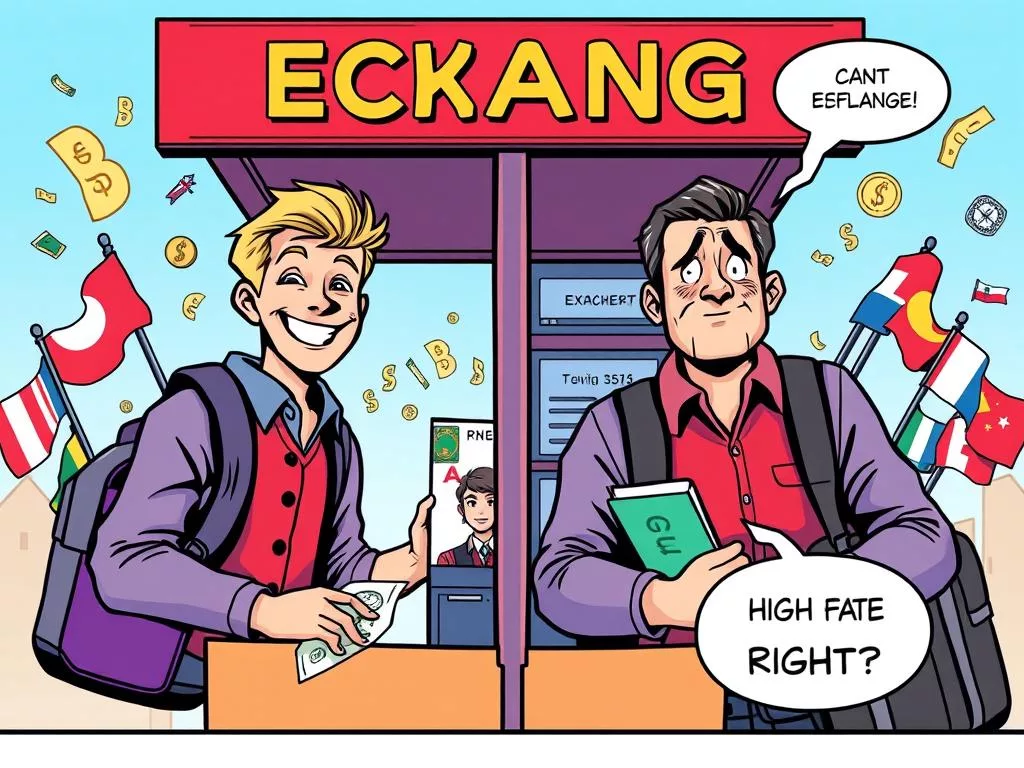When you travel abroad or handle foreign transactions, knowing about currency exchange fees is key. These fees, also called foreign transaction fees, happen when you switch currencies. Banks and credit card networks charge them, usually between 1% to 3% of the deal’s value.
Travelers need to grasp how these fees add up to their budget. It’s important to understand exchange rates and how to cut down on these fees. This knowledge can greatly reduce your expenses.
Using ATMs abroad can be cheaper if you have the right bank. But, watch out for Dynamic Currency Conversion. It can give you bad exchange rates and hidden fees. Knowing these details helps you avoid unexpected costs when traveling.
What Are Currency Exchange Fees?
Currency exchange fees are costs you face when using foreign money. The main fee is the currency conversion fee, which banks charge for currency swaps. It’s usually 1-3% of the transaction. This can make your travel costs go up.
Another fee is the foreign transaction fee from credit cards or banks. It’s 1-3% of the transaction amount. But, some prepaid cards and credit cards can avoid these fees and offer good rates.
Dynamic currency conversion (DCC) is also a fee to watch out for. Merchants might convert your money at the point of sale. But, DCC often has higher rates and fees than your bank.

Don’t forget about ATM withdrawal fees. These can come from both your bank and the local bank. They can add up, so it’s smart to compare rates. For example, using ATMs from global banks like HSBC can save you money.
Here’s a look at different ways to exchange currency:
| Method | Typical Fee | Advantages | Disadvantages |
|---|---|---|---|
| Banks | 1-3% commission | Reliable and accessible | Higher fees compared to online services |
| Credit Cards | 1-3% foreign transaction fee | Convenient, possible rewards | Foreign transaction fees |
| Online Exchange Services | Lower or no fees | Better rates | Less accessible |
| Hotel Exchanges | Higher rates | Convenient | Expensive |
| ATM Withdrawals | Host and home bank fees | Competitive rates | Multiple fees |
To save on currency exchange fees, check out smart spending abroad. It has lots of tips and resources for planning.
How to Minimize Currency Exchange Fees
Reducing currency exchange fees can save you money when traveling or doing business abroad. Using credit cards with no foreign transaction fees is a smart move. These cards help avoid extra charges that can add up fast.

Another good idea is to use ATMs instead of dynamic currency conversion. ATMs usually give better rates and lower fees than merchants. Just make sure to use ATMs from trusted banks to avoid hidden fees.
Steer clear of exchanging money at airport kiosks. They often have bad rates and high fees. Instead, go to reputable banks or financial places in your destination country. Planning ahead and knowing your options is key to good currency exchange practices.
For those who travel or do business abroad often, consider multi-currency corporate cards. Cards like the Airwallex VISA Borderless Card can save a lot. They let you hold and spend in many currencies, cutting down on conversion fees. Plus, they often have low or no foreign conversion fees, saving you money.
Using tools to track exchange rates and time your transactions can also help. Apps and online platforms give you real-time data and alerts. This helps you make smart financial choices. For more on these fees, check out Investopedia’s guide on currency conversion fees.
Travel debit or credit cards made for international use are also a good choice. They often have lower fees and cover ATM withdrawal costs. This way, you can get cash without extra costs. According to FX PAL’s guide on minimizing exchange, planning and research are key to saving money.
Let’s look at the impact of FX fees. For example, a 0.5% fee on a $100 million transaction is $0.5 million. If fees go up to 2%, that’s $2 million. This is a big difference that could be used for business or savings.
Here’s a comparison of common transactions and their fees:
| Fee Type | Rate | Example Cost (on $100K) |
|---|---|---|
| FX Transaction Fees | 0.5% – 2% | $500 – $2,000 |
| Dynamic Currency Conversion | 3% – 13% | $3,000 – $13,000 |
| Card Issuer Fees | 2.25% | $2,250 |
| Merchant Markup | 1% | $1,000 |
By understanding and using the best currency exchange practices, you can cut down on these fees. This makes your international transactions cheaper.
Common Mistakes to Avoid in Currency Exchange
Travelers often make mistakes when exchanging currency, leading to extra costs. One big mistake is using high fee places like airports or hotels. These spots usually have bad rates and hidden fees, making things more expensive.
It’s better to find reputable banks or services that offer good rates and clear fees. This way, you can save money.
Another error is using dynamic currency conversion. It might seem easy, but it can cost you 3%-5% for card payments. Also, foreign transaction fees on cards can add another 3%-5% to your bill. Paying in local currency can save you from these extra costs.
Timing is key. Exchanging currency at the last minute can mean bad rates. Keep an eye on market rates and plan your exchanges when they’re good. This can save you a lot of money.
It’s also smart to carry local currency for places that don’t take cards. Credit cards often have foreign transaction fees, around 3%. Using cards without these fees can save you money. Look for banks or services that offer no-fee foreign transactions, like Monzo and Starling.
Travelers should also know about anti-money laundering (AML) and know-your-customer (KYC) rules. Following these rules helps avoid legal issues and fines. Keeping records of your transactions also makes exchanges safer and more efficient.
For more tips, check out the detailed guide on currency exchange mistakes. By avoiding these common errors, you can manage your money better and enjoy your trip without worrying about money.
Guide to Currency Exchange Fee
Understanding currency exchange fees is key to saving money. Knowing the different fees and their impact on your transactions is important. It’s also vital to choose the right financial products and know where to exchange currency.
Major banks like Bank of America, Citibank, and US Bank have different fees for currency exchanges. For example, Bank of America charges a $7.50 delivery fee for orders under $1,000. Citibank has a $5 service fee, but it’s waived for some customers. US Bank charges a $10 fee for transactions up to $300.
Travelers can use credit cards with no foreign transaction fees. Prepaid travel cards can also help by locking in rates and reducing fees. Services like Wise offer currency exchange in over 40 currencies with low fees starting at 0.41%.
Wise also makes currency conversion easy in over 150 countries. This means no spending fees or foreign transaction fees. In contrast, major banks like Chase Bank have exchange rate markups of 2% to 6%. There are also extra costs for wire transfers.
It’s important to know the current exchange rates from reliable sources before exchanging currency. You can find useful currency exchange tips online. These tips can help you understand bank fees and compare rates to make better choices.
Using ATMs affiliated with major banks can also save you money. This way, you can avoid high foreign ATM fees and charges. Planning your currency exchange needs ahead of time and exchanging less often can also help save money in the long run.

